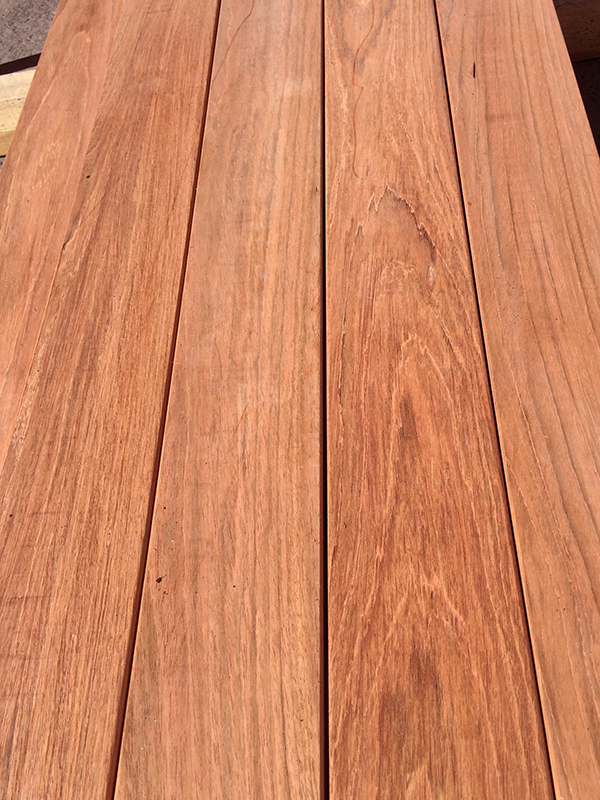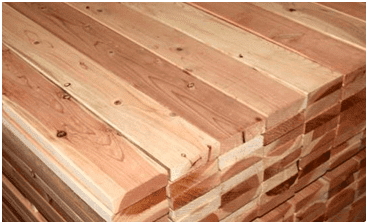If you’re wondering, “Can cherry wood be used outdoors?” you’ve come to the right place! Whether you’re planning to build a patio set or a wooden deck, the choice of wood is crucial. In this guide, we’ll explore the versatility of cherry wood and whether it can withstand the elements. So, let’s dive in and uncover the answer to this burning question!
First things first, let’s talk about cherry wood. Known for its rich, reddish-brown color and smooth texture, cherry wood is commonly used in furniture making. It’s prized for its natural beauty and durability. But when it comes to using cherry wood outdoors, there are a few things to consider. Will it fade in the sun? Can it handle rain and humidity? We’ll find out!
While cherry wood is undeniably gorgeous, it’s not the most ideal choice for outdoor projects. Although it’s strong and resistant to decay, it doesn’t fare well when exposed to the elements for extended periods. Over time, cherry wood may warp, crack, or fade when exposed to direct sunlight, rain, and fluctuating temperatures. But don’t fret! There are ways to protect cherry wood and make it suitable for outdoor use.
While cherry wood is often seen indoors, it can also be used for outdoor projects. To ensure its durability, take these steps:
1. Seal the wood – apply an exterior wood sealer to protect it from moisture.
2. Protect from UV rays – use a clear UV-resistant finish to prevent fading.
3. Regular maintenance – reapply sealer and finish every 1-2 years.
By following these steps, you can enjoy the beauty of cherry wood outdoors for years to come!

Can Cherry Wood Be Used Outdoors?
When it comes to choosing the right type of wood for outdoor use, durability and resistance to weather elements are key factors to consider. One popular choice is cherry wood, known for its rich color and natural beauty. However, before using cherry wood outdoors, it’s important to understand its characteristics, potential challenges, and proper maintenance. In this article, we will explore the suitability of cherry wood for outdoor applications and provide insights on how to make the most of this versatile material.
The Characteristics of Cherry Wood
Cherry wood, known for its warm reddish-brown tones and smooth grain pattern, is a highly prized material used in cabinetry, furniture, and other woodworking projects. It has a natural luster and ages beautifully over time, developing a deeper patina. Despite its aesthetic appeal, cherry wood does have some inherent characteristics that can affect its performance outdoors.
Firstly, cherry wood is a relatively soft hardwood compared to other popular outdoor wood species like teak or cedar. This means it may be more prone to denting and scratching, especially when exposed to heavy use or harsh weather conditions. Additionally, cherry wood is not naturally resistant to decay and insect infestations, which can be problematic when used outdoors where exposure to moisture and pests is inevitable.
Despite these characteristics, cherry wood can still be used outdoors with proper care and maintenance. By understanding its limitations and implementing protective measures, you can enjoy the natural beauty of cherry wood in your outdoor projects.
Protecting Cherry Wood Outdoors
To ensure the longevity of cherry wood in outdoor applications, several protective measures can be taken. One of the most important steps is to apply a high-quality finish or sealant that provides a barrier against moisture, UV rays, and other environmental factors.
When selecting a finish, choose one that is specifically designed for outdoor use and suitable for cherry wood. Look for products that offer UV protection, waterproofing capabilities, and resistance to mold and mildew. Applying multiple coats and maintaining regular reapplications according to the manufacturer’s instructions will help enhance the durability and longevity of cherry wood in outdoor settings.
In addition to finish, proper installation and regular maintenance are crucial for preserving cherry wood. When using cherry wood for outdoor furniture, it’s important to provide adequate ventilation to prevent moisture buildup. This can be achieved through the use of slats or gaps in the design to allow for airflow. Regular cleaning, drying, and inspection for signs of wear or damage will also help identify and address any issues before they worsen.
Tips for Using Cherry Wood Outdoors
1. Consider the location: Choose areas that provide some shade and protection from direct sunlight and excessive moisture to minimize the impact of weathering on cherry wood.
2. Use proper fasteners: When assembling outdoor structures with cherry wood, opt for stainless steel or other corrosion-resistant fasteners to prevent rusting and discoloration.
3. Regular cleaning: Remove debris, dirt, and stains from cherry wood surfaces using mild soap and water, followed by thorough rinsing and drying. Avoid using harsh chemicals or abrasive cleaners that can damage the wood.
4. Seasonal protection: During harsh winter months or periods of heavy rainfall, consider covering the cherry wood furniture or structures to protect them from excessive moisture and prolonged exposure to the elements.
By following these tips and taking necessary precautions, cherry wood can be a beautiful addition to your outdoor living space. With the proper care and maintenance, this versatile material can withstand the challenges of outdoor environments and provide years of enjoyment.
Benefits of Using Cherry Wood Outdoors
Cherry wood offers several benefits when used in outdoor applications:
- Warm and natural aesthetic: The rich color and unique grain patterns of cherry wood add a touch of warmth and natural beauty to any outdoor setting.
- Ageing gracefully: Cherry wood develops a deeper, richer patina over time, enhancing its visual appeal and giving it a distinct character.
- Availability: Cherry wood is widely available and can be sourced from sustainable forestry practices, making it an environmentally-friendly choice.
- Repairability: Despite its susceptibility to dents and scratches, cherry wood is relatively easy to repair and restore using simple woodworking techniques.
- Customizability: Cherry wood can be easily shaped, carved, and finished to create unique and personalized outdoor pieces.
Factors to Consider When Using Cherry Wood Outdoors
While cherry wood offers many benefits, there are a few factors to consider when deciding whether to use it outdoors:
- Durability: Compared to other outdoor wood species, cherry wood is relatively soft and may require more maintenance and care to ensure its longevity.
- Protective measures: Applying a suitable finish and regularly maintaining cherry wood are essential to protect it from moisture, UV rays, and other environmental factors.
- Cost: Cherry wood is considered a premium hardwood, which may be more expensive compared to other options.
- Availability: Depending on your location, cherry wood may not be as readily available as other outdoor wood species.
Conclusion
Cherry wood can be successfully used outdoors with proper care, maintenance, and protective measures. Understanding the characteristics of cherry wood, implementing recommended practices, and considering its benefits and limitations will help you make an informed decision when using this beautiful wood species in your outdoor projects. By following the tips provided and enjoying the unique aesthetic of cherry wood, you can create an inviting outdoor space that stands the test of time.
Key Takeaways: Can Cherry Wood Be Used Outdoors?
- Cherry wood can be used outdoors, but it requires proper maintenance to protect it from the elements.
- Applying a protective finish, such as a sealant or varnish, can help cherry wood withstand outdoor conditions.
- Regularly cleaning and reapplying the protective finish will prolong the lifespan of the cherry wood when used outdoors.
- Cherry wood may be more susceptible to damage from moisture and sunlight compared to other types of wood, so extra care is needed.
- Considering alternative outdoor woods, such as teak or cedar, may be a good option if you want minimal maintenance and durability.
Frequently Asked Questions
Curious about whether cherry wood can be used for outdoor projects? Here are some commonly asked questions to help you understand if cherry wood is suitable for outdoor use.
1. Is cherry wood suitable for outdoor furniture?
Cherry wood is not the most ideal choice for outdoor furniture due to its vulnerability to weather and moisture. While it is a beautiful wood known for its rich color and fine grain, cherry wood is prone to rotting, warping, and discoloration when exposed to outdoor elements.
To ensure the longevity of your outdoor furniture, it’s recommended to opt for woods such as teak, cedar, or redwood, which possess natural resistance to decay and weather. These woods can withstand outdoor conditions better and require less maintenance compared to cherry wood.
2. Can cherry wood be used for outdoor decking?
Using cherry wood for outdoor decking is not recommended. While cherry wood is durable and suitable for interior applications such as flooring or cabinetry, it lacks the natural resistance required for outdoor decking. Moisture, UV exposure, and temperature fluctuations can cause cherry wood to degrade and weaken over time.
If you’re considering decking materials, it’s advisable to choose hardwoods specifically designed for outdoor use, such as treated lumber, composite decking, or tropical hardwoods like ipe. These materials are better equipped to handle the challenges posed by outdoor environments.
3. Can cherry wood be used for outdoor trim?
Using cherry wood for outdoor trim may not be the most practical choice. While cherry wood can add elegance and charm to indoor spaces as trim or moldings, it is not naturally resistant to moisture and weather-related damage. Consequently, cherry wood trim exposed to the elements may deteriorate and require frequent maintenance or replacement.
If you’re looking for outdoor trim, consider alternative materials like PVC trim boards or engineered wood that are designed to withstand outdoor conditions. These materials offer the aesthetic appeal of wood without the susceptibility to rot and decay.
4. What precautions can be taken to use cherry wood outdoors?
If you are determined to use cherry wood for outdoor projects, you can take certain precautions to enhance its durability. Applying a high-quality outdoor sealant or finish will help protect the wood from moisture and UV damage. Regular maintenance, including cleaning and reapplying the sealant, is essential to prolong the lifespan of cherry wood used outdoors.
Additionally, it’s advisable to provide proper shelter or covering to minimize exposure to rain, direct sunlight, and extreme weather conditions. These precautions can help mitigate some of the risks associated with using cherry wood outdoors, but keep in mind that it may still require more maintenance compared to other woods specifically designed for outdoor use.
5. Are there alternative wood choices for outdoor projects?
Absolutely! If you’re looking for wood that is naturally suited for outdoor projects, consider woods like teak, cedar, or redwood. These woods have natural properties that make them resistant to decay, moisture, and insect damage, making them great choices for outdoor furniture, decking, and trim.
Alternatively, you can explore composite materials or synthetic wood options that mimic the appearance of real wood but are engineered to withstand outdoor conditions without the need for regular maintenance.

Summary
Cherry wood can be used outdoors, but it needs proper care to avoid damage.
Regular sealing and protective coatings can make it resistant to moisture and sunlight.
However, it is still important to keep it away from direct exposure to rain and extreme weather conditions.
By following these precautions, cherry wood can be a beautiful and durable choice for outdoor furniture and structures.
